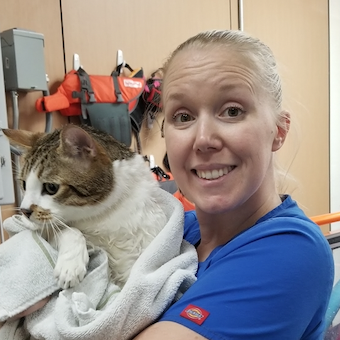When we hear the term training in veterinary medicine, there are either one of two reactions: “YES!” 🥳 or “Not again…” 😮💨
It’s somehow become a polarizing topic, and definitely not one that everyone is ready or willing to tackle.
So, how can we make training less polarizing and more engaging for our team?
Understand the difference between training, coaching, and teaching
It’s a fairly common misconception that training & coaching, when pertaining to clinical skills, are synonymous.
Spoiler alert: they’re not.
We train the skill.
We coach the person.
Let’s set the scene. A brand-new grad is working with you and is about to place their first IVC. You are training them in the preparation, technique & execution of this particular skill. However, you are coaching them through the process by your encouragement, reminding them to breathe, and either congrats on a job well done or refocusing them if things didn’t go so well.
Another term that gets tossed into the mix is teaching.
This is another term with loads of definitions but in our world, teaching is the combination of training and coaching. When you’ve taught a skill, you have not only instilled the know-how but the know-why. A powerful message, which is no wonder why teachers are true superheroes.
Create a comprehensive plan for your veterinary training
It’s all well and good to define the terms, the next, and most critical part is putting them into action.
Don’t be afraid to outsource training
This can be a challenge, especially given the time & team member constraints – ‘We don’t have enough of either! What do we do?’
This is when & where outsourcing is necessary. It’s not a sign of weakness to ask for help, on the contrary, it’s a sign of strength — recognizing when you’ve reached your limits and when to call in the reserves.
This also signals to your team that you recognize that they’re tapped out. Both in the time they have, and the energy with which they’d need to give it.
Add structure to your training
A practice’s success hinges on the creation of a standardized, structured & engaging program — enabling new team members to integrate seamlessly and providing opportunities for the current team to go from surviving to thriving.
We’ve all experienced the sink-or-swim method, and even for those of us who can do more than doggy paddle, it’s not a pleasant experience. Guidance is necessary, sometimes lifesaving & there are so many skilled team members we need to support who feel stuck and cannot see the way up and onward.
Focus on individual growth & incentives
We must shift the focus off of the individual and onto the process.
Labels are only good for Rx’s, so we should drop the “beginner” or “Level 1 teammate” labels.
We’re all learning and developing our skills — progressing from a starting point to one of experience. Standardize the markers of success, and make sure that there are more incentives in place than food (not everyone is as food motivated as a Labrador).
Once we are all on the same playing field, it is that much easier to up the ante. When we have a standardized approach to evaluating our teams wholly, a clear path toward advancement in skills – clinical & human, a competency-based system for determination of elevation, everybody wins, and our profession grows.
Never stop adapting & evolving veterinary team training
If we’ve learned anything over these past two years, in particular, it’s that change is inevitable.
Regardless of whether we like it or not, we either have to embrace the suck & make it work or get left behind. Sound harsh? It’s not meant to, but sometimes reality is. Look at the animal kingdom & what they have to do. Adapt to survive, or in other terms – evolve.
We’ve done this in medicine before, so it’s not an entirely new concept. We used to use thiopental for anesthetic induction and now, not so much! What is new, is applying this advancement, this evolutionary outlook to how we build our teams. Is it easy? No. Will it happen overnight? Also no. But is it worth it? 100%.
We must make the time – intentionally make it a priority – and put in the effort (whatever that looks like) to get this process going. Stop the runaway train of on-the-job, we’ll figure it out as we go approaches to learning & growing in vet med. Plan your trip, know where you’re heading.
And if you get lost along the way? Ask for directions. Listen to them. Put them into motion. Then start this next journey with us, and get on board.
Want to be intentional about the culture in your practice? Check out rally!




.gif)


